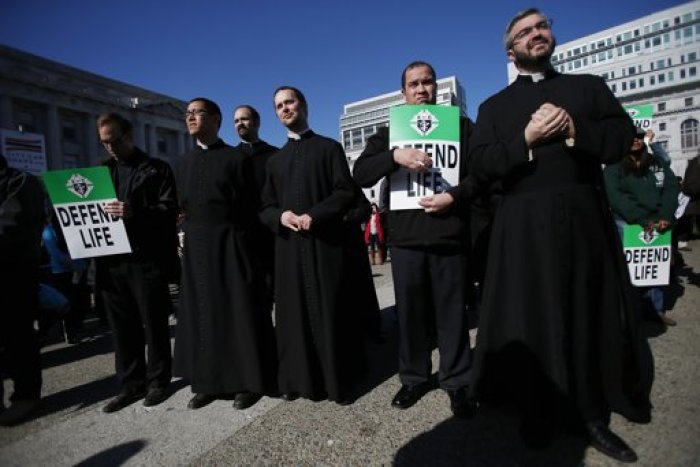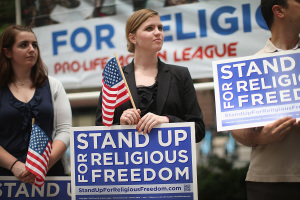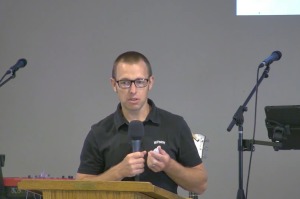Why Do Many Pro-Life Catholics Vote Democrat?

WASHINGTON — Why do Catholics who are aligned with Democrats on social welfare and Republicans on abortion usually vote Democrat? Recent political science research suggests an answer.
Some Catholics who vote for Democratic candidates incorrectly assume those candidates are pro-life.
Catholics are often used as an example of "cross-pressured voters" due to the political party positions on abortion and welfare. Laura Hussey, associate professor of political science at University of Maryland, Baltimore County, and Geoffrey Layman, professor of political science at University of Notre Dame, however, found that a minority of Catholics were both pro-life and pro-welfare, and those that were showed little ambivalence in their vote choice.
Their research, "Coping with Cross-Pressures: Electoral Choice and Political Perceptions among American Catholics," was presented Friday at the American Political Science Association Annual Meeting.
About 14 percent of all Catholics hold policy views consistent with the view of the U.S. Conference of Catholic Bishops — they favor increasing government social welfare programs and they are opposed to abortion. And these Catholics, by far, prefer Democrats when they vote. Only about 24 percent vote Republican.
Committed Catholics were more likely to hold the pro-welfare/pro-life (PW/PL) views. While only 14 percent of all Catholics were PW/PL, 25 percent of committed Catholics held those views. Among non-Catholics, religious commitment made less of a difference: 14 percent of all non-Catholics and 17 percent of non-Catholics with religious commitment were PW/PL. Hussey and Laymen also found that being a committed Catholic increased the likelihood of being PW/PL even when controlling for other factors, which suggests that being a committed Catholic makes a unique contribution to being PW/PL.
Besides being Catholic, those with lower levels of income, education and political information were also more likely to hold PW/PL views. In some, but not all, of their multivariate models, being young, female, black, a Southerner or in a household with a union member also showed a statistically significant greater likelihood of being PW/PL.
While most PW/PL committed Catholics were Latino, the differences between Latinos and non-Latinos among PW/PL Catholics were small, suggesting that Latino identity was not a causal factor.
The most interesting part of Hussey and Layman's findings was that PW/PL Catholics do not show signs of being a cross-pressured voter, or difficulty deciding who to vote for because there are parts of each political party they prefer. Unlike cross-pressured voters, PW/PL Catholics are not ambivalent about which candidates they prefer.
One reason, Hussey and Laymen found, is that PW/PL Catholics incorrectly assume that the Democratic candidates they vote for are pro-life.
Forty-three percent of PW/PL Catholics believed a pro-choice Democratic candidate was pro-life, which was much higher than the rate of misperception among other Catholics. Hussey described the misperception as a psychological coping strategy to deal with the cognitive dissonance that results from being PW/PL.
"Pro-life, pro-welfare Catholics generally seem to deal with this dissonance by projecting their church's [views on abortion], which also happens to be their own view ... onto their candidate of choice," Hussey said during her panel presentation.
These Catholics are "not agonizing" about their vote choice, she added, because their "policy knowledge of politicians is pretty inaccurate."
Some Catholic Republican politicians, such as Wisconsin Rep. Paul Ryan and former Pennsylvania Senator Rick Santorum, have begun to promote a new conservative social-welfare agenda. Ryan presented a welfare reform plan in July. Santorum had a book published this year, Blue Collar Conservatives, that discusses ways Republicans can reach working class voters. Both of these overlap some with what has been described as the "new populism" or "libertarian populism."
In response to a question from The Christian Post, Layman speculated that "Ryan may be onto something" when it comes to Republicans reaching PW/PL Catholics, because social welfare is a more important issue for them than abortion.
"It's actually the social welfare part that is inhibiting the committed Catholics to vote for the Republican Party [in numbers that] we would expect ... based upon abortion positions," he said.
A focus on social welfare issues would also be especially important, the paper's findings suggest, for reaching Latinos, since most of the PW/PL committed Catholics were Latino.
"Especially if the Republicans are interested in winning Latino committed Catholic votes, they would have to be different on social welfare," Layman said.
To get a large enough group of Catholics, the study pooled data from the American National Election Studies for election years from 1992 to 2008.




























